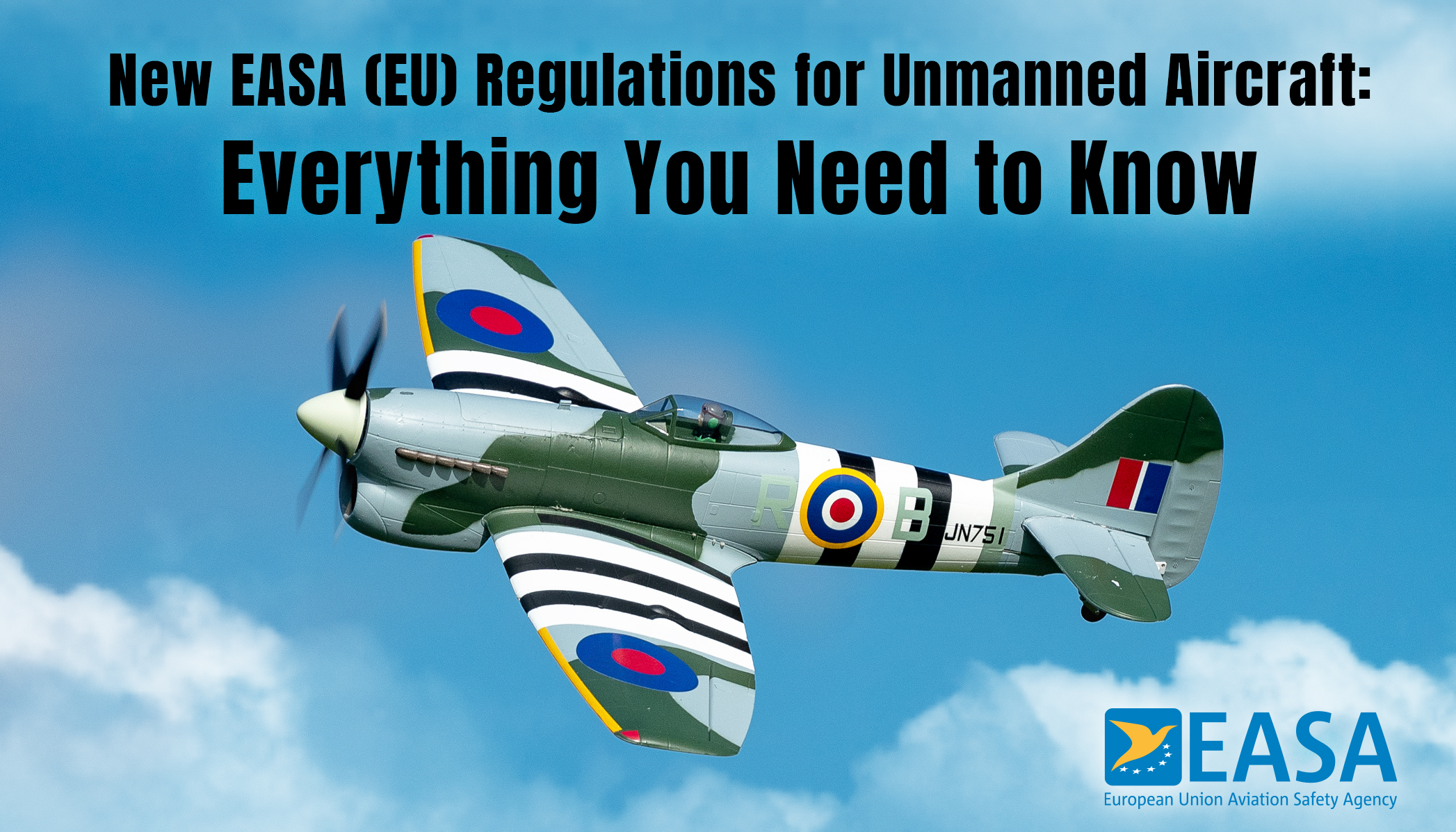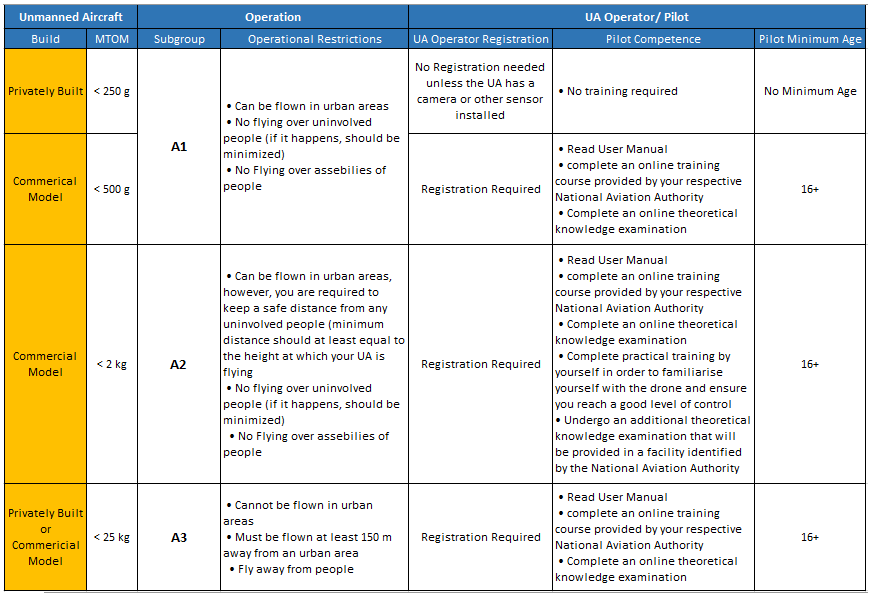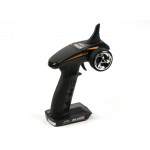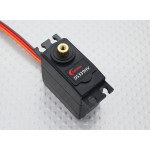
The new EASA Unmanned Aircraft Regulation has been enacted into law on the 31st of December 2020. But what does that mean for you as a recreational flyer? Here is everything you need to know broken down into bite-sized sections.
What is the New EASA Unmanned Aircraft Regulation (2019/947 & 2019/945)
The new EASA regulation aims to consolidate and standardize all operations of Unmanned Aircraft (UA) in the EU airspace. Adopting a risk-based approach, the new rules do not distinguish between commercial and leisure activities; but are based on the weight and specifications of the UA - combined with the scope of operation. Ultimately, the regulatory framework will make flying UA in the EU much simpler, and pave the way for greater commercial adoption.
What Does Unmanned Aircraft Include?
According to the EASA, an Unmanned Aircraft is any aircraft operating or designed to operate autonomously or to be piloted remotely without a pilot on board. So, this includes RC planes, helicopters, and drones.
Who Do the New Rules Apply to?
The new rules apply to all UA operations in the European airspace; this includes EU Members and EASA Member States. If you are a non-EU visitor wishing to operate in the European airspace, you will also need to abide by the new rules.
Mandatory UA Operator Registration
First things first, if you haven't already registered yourself as a UA operator/owner, do so with the National Aviation Authority of the EU country you reside in. You only need to register once regardless of how many UA you own. Once registered, you will receive an “Operator Registration Number” that needs to be displayed with a sticker/label on all the UA you own.
The Three Categories of UA Operations
Based on the types of operation and their corresponding levels of risk, three categories of operations have been defined in the new framework: the Open Category (low-risk), the Specific Category (medium-risk), and the Certified Category (high-risk).
Most recreational flyers will fall under the Open Category so for the purpose of this blog, we will focus more on that. The Specific Category and the Certified Category are geared more toward commercial activities including but not limited to flying beyond the visual line of sight, flying at a height over 120 meters, flying over people, and transporting goods with high risk in case of an accident.
The Open Category
It is important to recognize that the new framework is not just a set of guidelines dictating where you can and cannot fly, it is more of a holistic approach where specific prerequisites must be met before you undertake certain types of operations.
With this in mind, the Open Category is further broken down into three subgroups: A1, A2, and A3. Each subgroup has its own set of requirements, however, before determining which subgroup you fall into, you must first verify you're operable in the Open Category.
Here are the prelim criteria to fly under the Open Category:
- Your UA (privately built or purchased) weighs below 25 kg;
- Your operation will not involve flying over people unless your UA weighs less than 250 g;
- Your operation will be maintained in visual line of sight (VLOS) or the remote pilot will be assisted by a UA observer;
- Your operation is flown at a height no more than 120 meters;
- Your operation will not carry any dangerous goods and will not drop any material.
Once you have confirmed that you are operable under the Open Category, you need to determine which subgroup you belong to. After January 1, 2023, all commercially manufactured UA will consist of a “class identification label” ranging from C0 to C4. The class identification label will ultimately determine which subgroup you can fly under, however, in the interim, you can refer to the table below.
Subgroup A1
Subgroup A1 essentially allows you to fly almost everywhere except for crowded places, over assemblies of people, and areas that your respective state has forbidden by imposing a restriction on flight of drones. Privately built UA not weighing more than 250 g can freely fly under A1 without any training or age restriction.
Commercial models weighing under 500 g can only be flown under A1 if the operator is at least 16 years old, have registered as a UA Operator, read the user manual, completed an online training course provided by their respective National Aviation Authority, and have passed the online theoretical knowledge examination.
Subgroup A2
Subgroup A2 allows operators to fly in urban environments, however, a minimum “safe” distance must be kept between uninvolved people. The “safe” distance can be defined as the distance equal to the height at which the UA is flying (e.g. if you are flying at a height of 30 m, make sure that the closest uninvolved person is at least 30 m from the position where the UA would vertically fall in the event of an incident).
Commercial models weighing under 2 kg can be flown under A2 only when the operator is at least 16 years old, have registered as a UA operator, read the user manual, completed an online training course provided by their respective National Aviation Authority, passed the online theoretical knowledge examination, completed practical training, and have passed an additional theoretical knowledge examination provided in a facility identified by the National Aviation Authority.
Subgroup A3
Subgroup A3 only permits operators to fly outside of urban environments with the UA kept at least 150 m away from the closest residential, commercial, or industrial infrastructure(s); and where no uninvolved people are present in the operable range of the UA.
Privately built or commercial models weighing up to 25 kg can be flown under A3 only when the operator is at least 16 years old, have registered as a UA Operator, read the user manual, completed an online training course provided by their respective National Aviation Authority, and have passed the online theoretical knowledge examination.
---
How to Stay Updated
If you want to get the latest news and updates regarding the new EASA UA Regulation or any others which may arise, then keep in touch with us by following us on Facebook or subscribing to our emails.







